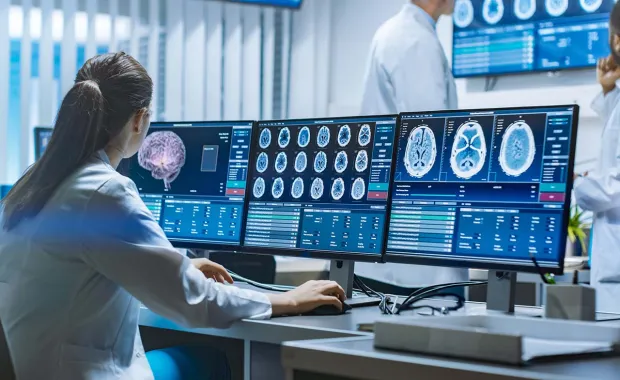Imagine driving to an appointment when, suddenly, intense pain causes you to pull over. You manage to call emergency services just before losing consciousness. You wake up in an ambulance to hear the voices of paramedics, hospital staff and your primary care physician. From different locations, these professionals consult on your treatment as they refer to your medical history, medications, allergies and live feeds from the scanners and sensors attached to your body. The ambulance takes you to a nearby health facility where the staff is ready to treat you based on the ambulance consultation. After your hospital stay, you return home with smart devices to monitor your recovery progress.
This scenario illustrates how health technologies can transform hospitals into hubs for collaboration in a people-centric approach. It shows how clinical and non-clinical staff can share information and communicate securely to deliver holistic care. It also shows how the home might help services to be delivered in a decentralized manner. Healthcare facilities can be reimagined to be distributed and connected and go beyond their brick and mortar structures.
An aging population, rising healthcare costs and talent shortages are driving a new vision for hospitals and care facilities in many parts of the world. This vision reframes the traditional organization-centric care model by putting people at the center.
People-centric health care prioritizes the multidimensional needs of people — patients, their families, health professionals and supporting staff — and includes home-based services and other decentralized care delivery. Looking beyond the disease or the intervention, this approach focuses on individuals across the continuum of care – from preventative to episodic, chronic and end-of-life services.
Data-driven delivery is key to people-centricity
Data-driven care delivery is key to designing, implementing and operating a people-centered care model. It relies on the secure movement of accurate and relevant patient data, which is also critical to enabling smart care. ‘Smartness’ arises from insights delivered to the user. It requires investment to enable the systematic capture, refinement and shared use of data and insights to simplify patient flows, facilitate care delivery, grow knowledge-based practice, and operate efficiently. Smart care helps organizations:
- Optimize care flows and simplify administration to concentrate scarce resources to respond efficiently to the population's health needs
- Enable better user experiences for patients, providers and administrators alike
- Automate workflows and connect people across the boundaries of facilities, organizations and specialties of the healthcare system
- Amplify the effectiveness of different parts of the health system[1], providing continuous availability of services for acute and complex conditions
While moving to a smart care approach is desirable for many health organizations, the reality is that there are many obstacles in the data supply chain.
For hospitals to realize the greatest benefits from digitalization initiatives, they must act on two levels:
- Collaborate with suppliers to establish a shared understanding of the bottlenecks that prevent cohesive patient flows, and how to simplify administration throughout the patient journey (for example, using technology to optimize resource allocation, staff scheduling and material requirement planning).
- Convene forums to discuss and agree on data aggregation and the pragmatic use of standards that secure interoperability, a foundation for better quality and more efficient care. (I invite you to read more on this topic in my colleague Brad Schoffstall’s blog, Three strategies for health data interoperability success.)
Enabling smart care across different settings
Following are examples of how smart care can bring benefits across various settings:
- Smart hospitals: Smart care approaches enable hospitals to reimagine their services and structures to provide patient-centered, data-enabled tools like self-check-in, digital hospital guides and self-monitoring personal/home medical equipment. These tools generate valuable data for controlled and predictable development work such as clinical trials.
Similarly, technologies such as artificial intelligence can enable completely new types of care diagnosis, such as interpreting X-rays and providing specialized solutions for cardiology, pathology and self-monitoring during investigation or treatment. However, these tools must be able to connect seamlessly across the healthcare ecosystem to support a holistic, people-centered care model.
- Smart care at home: A smart care ecosystem architecture can facilitate at-home care, administered by patients themselves and/or caregivers. In such a system, wearables and other personal medical devices, as well as equipment and furniture with embedded sensors, can track vital signs, activity and movement, medication and medication dispensing. These devices also could securely relay information to primary care physicians, social and community care services, specialist and emergency room (ER) services, as well as pharmacy, imaging and labs and/or diagnostic clinics.
- Decentralized care through adaptive building reuse: Traditionally, healthcare services are delivered on site, requiring adequate space for practitioners. The cost of a new hospital is significant, and could be reduced by reusing existing buildings — such as office buildings, warehouses and multi-family housing — to create decentralized and sustainable hospital care that’s conveniently located within communities. While the adaptive reuse of existing buildings offers a sustainable and affordable way to expand healthcare facilities that can improve the delivery of care, it requires robust digital infrastructures to operate seamlessly.
- Trusted digital infrastructure is the foundation for smart care. An interoperable ecosystem would allow healthcare personnel to collaborate and make better clinical decisions for their patients, regardless of the type of site. Trusted digital infrastructures are central to scaling the health system and allowing a wide range of actors to interoperate securely – both within the health sector and across sectors.
Contact us to help advance the discussion of how patient-centered, data-enabled tools can redefine the future of hospitals and care facilities. Our expertise in building and managing secure digital infrastructure can support your hospital in moving to a smart care approach.
Learn more about how CGI is empowering healthcare organizations to optimize operations and improve patient outcomes through the responsible use of AI
[1]The World Health Organization defines health system as the organizations, people and actions whose main purpose is to promote, restore or maintain health. This includes efforts to influence determinants of health, as well as more direct health-improving activities.




